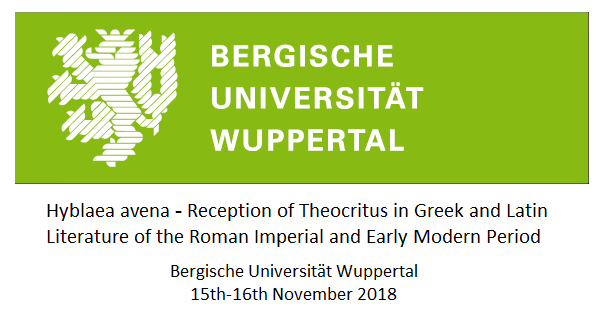CALL. 30.04.2018: Hyblaea avena. Reception of Theocritus in Greek and Latin Literature of the Roman
- fasticongressuum

- 24 mar 2018
- 3 Min. de lectura

FECHA LÍMITE/DEADLINE/SCADENZA: 30/04/2018
FECHA CONGRESO/CONGRESS DATE/DATA CONGRESSO: 15-16/11/2018
LUGAR/LOCATION/LUOGO: Bergische Universität Wuppertal (Wuppertal, Germany)
ORGANIZADOR/ORGANIZER/ORGANIZZATORE: Jun.-Prof. Dr. Stefan Weise (Bergische Universität Wuppertal); Anne-Elisabeth Beron, M.A. (Bergische Universität Wuppertal)
INFO: weise@uni-wuppertal.de - beron@uni-wuppertal.de
CALL:
Pipes being handed down from one shepherd to another in the tradition of music making can easily be imagined as a scenario in real life, whether in ancient times or today. And indeed, some pipes from antiquity are still in use 2000 years later, at least metaphorically speaking. Easy to track are the ones Theocritus used in creating the genre of pastoral poetry with idyllic landscapes and characters that seem to be transported from their real life duties and dialogues into the realm of verses. His pipes are depicted as the instrument of the predecessor offered to a poet of a new era and language in Virgil’s 10th eclogue (Verg. ecl. 10,51: carmina pastoris Siculi modulabor avena), and are from there given to another even later poet in Theocritus’ and Virgil’s footsteps, Calpurnius Siculus (Calp. 4,62f.: Tityrus hanc [sc. fistulam] habuit, cecinit qui primus in istis / montibus Hyblaea modulabile carmen avena).
This tradition was renewed, when the Greek text of Theocritus was rediscovered and printed for the first time during the Renaissance. Thus, Joachim Camerarius, for instance, coined Greek and Latin verses inspired both by Virgil and Theocritus. Finally, the Leipzig schoolmaster Johann Gottfried Herrichen even staged his Greek idylls so that they came back to life using perhaps also real pipes.
Hence a tradition and continuity in the bucolic genre and beyond can be traced back to the inventor, still hundreds of years later. As others have recently concentrated on the reception of Theocritus in comparative studies beginning in antiquity moving to modern times and modern languages (e.g. M. Paschalis [ed.]: Pastoral Palimpsests. 2007; H. Seng/I. M. Weis [eds.]: Bukoliasmos. 2016), the two day-conference Hyblaea avena aims at a new focus in a selected and narrower timeframe, namely the reception of Theocritus in Greek and Latin literature in the Roman empire (1st-6th c.) and the early modern age (15th-17th c.). Within the early modern period, we would like to concentrate on imitations in Greek but of course not exclusively. A view into Byzantine literature is also welcome.
Beyond the passing of pipes the main focus of the meeting is exemplified by the following questions that can be asked or can be answered afresh:
· What role did the reception of Theocritus play in Greek and Roman literature?
· How is the imitation of Theocritus made explicit?
· Which part of Theocritus was used and which was neglected?
· Is the imitation of Theocritus sometimes deliberately left out and why?
· What are the new contexts and functions of Theocritean scenarios and allusions?
· How was Theocritus integrated into other literary genres (e.g. epic poetry or anacreontic verse)?
· What was the impact of the edition of Theocritus, either as the original text or as a translation?
· How did the renaissance of Theocritus during the early modern age change the way poetry was written?
We cordially invite papers of approx. 20-30 minutes in length, with following time for questions and discussion. The languages of the meeting are German and English.
Please submit titles and abstracts (as pdf-attachments) of approx. 500 words, along with a short CV and contact details by 30th April 2018 to either Stefan Weise or Anne-Elisabeth Beron. Applicants will be notified of the organizers’ decision shortly thereafter.



Comentarios